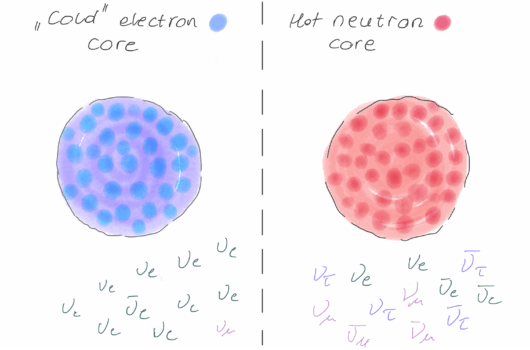Sandblasting the r-Process: Spallation of Ejecta from Neutron Star Mergers

Abundances in the third peak (180<A<200) of the r-process pattern produced with PRISM calculation of disk wind conditions of a neutron star merger event, before (blue line) and after spallation (red line) with initial ejecta velocity v=0.4c, compared to the solar r-process residuals shown in black points. In this scenario, the r-process abundance pattern is “sandblasted” to move towards the solar data after spallation, which happens during the propagation of the r -process nuclei through the interstellar medium.
When particles travel with high speeds (v> 0.1c; kinetic energy Ek> 5 MeV) in the interstellar medium (ISM), they are energetic to interact with the ISM particles by nuclear reactions. These reactions generally lead to spallation: fragmentation processes in which a heavy nucleus emits one or more nucleons, thus reducing its atomic weight.
Neutron star mergers (NSMs) are rapid neutron capture (r process) nucleosynthesis sites that expel matter at high velocities, from 0.1c to as high as 0.6c. Thus, the r-process nuclei ejected from an NSM are sufficiently energetic to initiate spallation reactions with the ISM particles.
In the r process, rapid neutron capture pushes material far from stability and shapes the characteristic abundance pattern with three distinct peaks (at mass numbers A~80, A~130, and A~196). These peaks are clearly seen in the abundance pattern of our solar system where approximately half of the heavy elements have an r-process origin.
Thick target approximation for the propagation of the r-process nuclei ejected from an NSM inside the ISM. In this scenario, all the r-process nuclei either lose energy gradually through ionization energy loss or have spallation reactions with ISM particles.
We adopt a thick-target model for the propagation of these high-speed heavy nuclei in the ISM, i.e., assuming all r-process nuclei either lose energy gradually through ionization energy loss or have spallation reactions with ISM particles. The ionization loss dominates the energy loss mechanisms, while the spallation reactions are responsible for the change in the abundance pattern of the r-process nuclei.
Comparing the initial abundances of r-process nuclei generated from PRISM nucleosynthesis calculation with the abundances after spallation, we find that spallation can result in non-negligible changes to relative abundances in the A~ 130 and A~195 r-process peak regions of material ejected with speeds above 0.2c. The effects of spallation are to move the abundance pattern towards lower mass numbers and smooth the slope at the left side of the peaks. The effect is bigger particularly around the low-mass edges of the r-process peaks where neighboring nuclei have very different abundances. Thus, after spallation, the r-process abundance peaks are “sandblasted” towards the flatter solar data.
Spallation effects on the second peak (110 < A < 140) and third peak (180 < A < 200) regions with PRISM calculation for a high-speed NSM dynamical ejecta simulation with initial velocity v=0.512c.
Upper panels: Abundances before (blue lines) and after (red lines) spallation, compared to solar r-process only data shown in black points. Lower panels: The abundance change ratio due to spallation, scaled to highlight the abundance changes in the second and third peaks themselves.
The extent to which spallation modifies the final NSM abundance pattern depends on: (1) the ejected abundances, which are determined by the NSM astrophysical conditions and the properties of nuclei far from stability, (2) the ejecta velocity distribution and propagation in ISM, and (3) the spallation cross-sections.
Read More:



